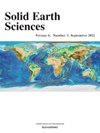尼日利亚东南部哈科特港部分地区土地利用对地下水质量的影响评估
IF 2
4区 地球科学
Q3 GEOSCIENCES, MULTIDISCIPLINARY
引用次数: 0
摘要
这项研究为Harcourt港地下水的地球化学和质量状况提供了见解,该地区位于尼日利亚南部的尼日尔三角洲沉积地区。地下水是在城市的住宅、商业、工业和跨越重要土地利用带的偏远地区的采样点收集的。对这些样品的化学分析表明,这些水的营养含量各不相同,并且有盐水侵入的痕迹。水是微酸的;饮用水限度内的化学参数和营养成分。阳离子和阴离子分别以Ca和gt为主;Mg祝辞K比;Na和Cl >;HCO3> SO4> 3号。重金属铅、铜、锌、铬和镉的浓度普遍高于可接受限度,其中工业区报告的浓度最高。主成分分析和相关性表明,化学物种之间存在相互关系,与盐度、硅酸盐风化和人为控制有关,并主要负责水的化学性质。通过水化学相图将研究区地下水划分为Ca-Mg-Cl-SO4型。水质指数(WQI)计算表明,不同土地利用带存在不同程度的水质差。根据污染指数(PI)评价,城市内外的人为活动是造成地下水高污染的主要原因。本文章由计算机程序翻译,如有差异,请以英文原文为准。
Assessment of land-use impacts on groundwater quality in parts of Port-Harcourt city, SE-Nigeria
This study offers insights into the geochemistry and quality status of groundwater in Port Harcourt, situated in the sedimentary Niger Delta region in southern Nigeria. Groundwater was gathered at sampling sites in the city's residential, commercial, industrial, and remote areas that crossed over important land-use zones. Chemical analyses of the samples show that the waters vary in nutrient amounts and have traces of salt water intrusion. The waters are slightly acidic; chemical parameters and nutrient within limits of potable water. Cations and anions, respectively, are dominated by Ca > Mg > K > Na and Cl > HCO3>SO4>NO3. The heavy metals Pb, Cu, Zn, Cr, and Cd, revealed concentrations generally above acceptable limits, with the industrial areas reporting the highest concentration levels. Principal component analysis and correlation indicate presence of interrelationships among chemical species, linked to salinity, silicate weathering, and anthropogenic controls, and primarily responsible for the chemistry of water. Groundwater in the research area is classified as Ca–Mg–Cl–SO4 type by the hydrochemical facies plot. Water quality index (WQI) calculations show that different land-use zones have varied degrees of poor water quality. According to Pollution Index (PI) assessments, anthropogenic activities in and around the city are the reason for the high level of pollution in the groundwater.
求助全文
通过发布文献求助,成功后即可免费获取论文全文。
去求助
来源期刊

Solid Earth Sciences
GEOSCIENCES, MULTIDISCIPLINARY-
CiteScore
3.60
自引率
5.00%
发文量
20
审稿时长
103 days
 求助内容:
求助内容: 应助结果提醒方式:
应助结果提醒方式:


